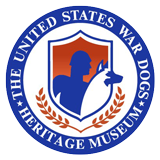1st Cavalry Division, 7th Regiment, Hq. & Hq. Co., K- 9 Platoon First K-9 unit to see combat during the Korean War
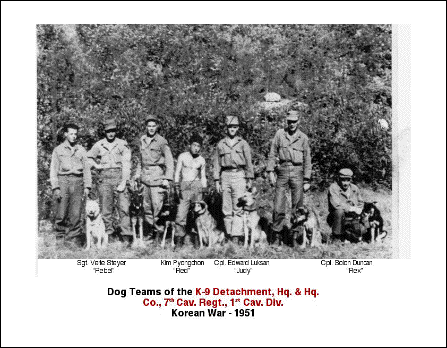
8A/FEC-51-29957
16 AUG 1951
WAR DOGS: SINCE NO ROTATION POLICY HAS BEEN SET UP FOR THE WAR DOGS OF THE U S 1ST CAV DIV, ONE OF THE DOGS, “JUDY”, TOOK MATTERS INTO HER OWN PAWS. HERE SHE IS WITH MEMBERS OF THE TACTICAL WAR DOG PLATOON, 7TH REGT, U S 1ST CAV DIV, HOLDING HER SIX NEW REPLACEMENTS. (L TO R) 1ST LT TED COOK ( BECKLEY,W. VA), PFC ED EMMONS (GRANITE CITY, ILL), SGT THEODORE MCKELVEY (CRESTWOOD, N. Y.), PFC VERLE STEYER (PIONEER, OHIO), PFC EDWARD LUKSAN (NEW SMYRNA BEACH, FLA), AND KIM PYONGCHON, KOREAN ASSISTANT. (2ND ROW, L TO R) CPL MACK HATFIELD, (HANOVER, W. VA), CPL CLIFFORD GRINSTEAD (SOUTH CHARLESTON, W. VA), AND PFC CARL BROOK (BREMEN, IND).
U S ARMYPHOTO BY CPL PAUL J SIMONS (BLQ) 13 SIG CO
STAFF DISTRIBUTION ONLY-NOT FOR PUBLICATION UNTIL RELEASED BY
GHQ PIO.
This K-9 Unit History was assembled by Theodore D. McKelvey, retired and living in Connecticut. You can contact him at :
1.) This unit resulted from the desire of T/Sgt Guy C. Sheldon, a World W.W.II veteran, to again apply his skills in support of the UN Army’s conflict raging on the Korean peninsula in the year 1950. T/Sgt Sheldon had served with a K-9 outfit during World War 11 in the Pacific theater of operations, and was involved in the early creation of the training manuals on the subject. One of his exploits that took place in the 1943 Cape Glouster campaign in New Guinea is documented on the U. S. War Dogs Association, Inc. web site.
2.) T/Sgt. Sheldon said he volunteered for duty in Korea to escape marital difficulties at home. After enduring the required refresher training, Sgt. Sheldon ended up in ‘Dog’ Co., 7th Cav Regt. After sharing a fifth of whiskey with his company commander one evening, T/Sgt Sheldon got permission to develop the nucleus of a K-9 group. A trip to Pusan was authorized so T/Sgt Sheldon could acquire, at his own expense, the needed tools of the trade. He returned to the front lines with dog food, choke chains, leather leashes, leather harnesses, leather saddle bags (fashioned by Korean artisans) and bowels to feed the dogs. T/Sgt Sheldon was very persuasive in gaining support for his project.
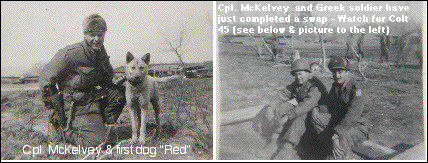
3.) Dogs needed for this startup effort were bought, begged, borrowed and stolen from the Korean civilian population. Platoon personnel were volunteers,friends of T/Sgt. Sheldon in ‘Dog’ Co. All activity/training was authorized to take place only during times when the unit wasn’t engaged in active combat with the enemy. Our training as handlers was very much like what you might see on current TV programs on the subject.
4.) After the period of training had proved to the upper command that this was a desirable tool, the unit was transferred from Dog Co. to Regimental Hq. & Hq. Co., and was led by 1st Lt. Ted Cook, who undertook the job in addition to his original assignment. A period of more formal training was scheduled, and was to span about a month in duration. At that time additional personnel were authorized, and recruited by the existing platoon members. I was a member of “C” Co. at that time and was recruited by Pvt. James D. Matty, Snowshoe, P.A., who I had befriended on board ship. The deal as proposed to me included a month free of combat to train the unit to a degree T/Sgt Sheldon considered combat ready.
5.) I had arrived in Korea on Christmas day of 1950 and was involved in many unpleasant engagements with the Chinese enemy as a member of Garry Owen. After experiencing being bombed and strafed by ‘Midnight Charlie’, attacked by masses of Chinese using whistles and bugles and being involved in frontal assaults against Chinese positions on mountain tops, the idea of a month off from combat had great appeal and I was quick to join up.
6.) During the training period I was assigned ‘Red’, a very intelligent dog, and as a team we developed into one of the ‘top teams’ of the unit. We were assigned the task of proving to everyone that the dogs were ready to support combat troops. A test was rigged to present the team with opportunities to prove that the dogs superior sense of hearing and smell would give a patrol an edge over the enemy.
7.) The ‘test’ was a night time roving patrol (you couldn’t see your hand in front of your face) with ‘Red’ in the lead, followed by me with leash in hand. The patrol leader next in line, followed by a squad of rifleman in single file. ‘Red’ halted when sensing something of interest, whether it be a rabbit or an enemy patrol. Following the leash to find the dog’s head I determined the direction of the unknown by feeling what direction my dogs head was pointing, then relayed that information to the patrol leader, who in turn assigned a member/s of the the patrol the task of identifying the unknown. The results were excellent, ‘Red’ having acquired all the possible ‘enemy’ well before they were aware of the patrol. From that time on, one or more Dog Team was assigned almost every night, to join patrols that could best benefit from the dogs keen senses.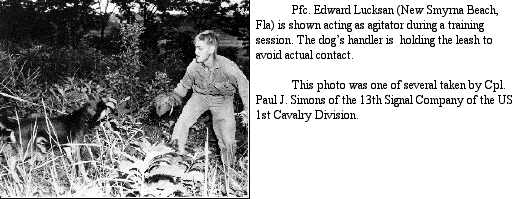
8.) Training: Man and dog were very close. Each dog got its training and complete care from only one man. The bond that developed would later prove to be a disadvantage to one team. Handler dug a hole at every new location for himself and one for his dog to sleep in, free from exploding enemy artillery shells. The man’s sleeping hole was dug for two, 4’ x 7’ x 4’ deep, with entry steps, lined with ponchos and blankets, covered with a two man pup tent and connected to the Co. generator for a single light bulb. The dogs were fed once a day a mixture of canned horse meat mixed with rolled oats and water. This diet kept them healthy and happy. Recruiting of new dogs continued, one a pet, volunteered by a Lt. in the 3rd Div., another I bought from a metropolitan policeman in Seoul for $20 military script. The dogs were selected only because of their availability, but some were considered less than desirable due to size and coloring. They ranged from small near white mutts to large black pure blooded dogs. They were all trained and all saw combat.
9.) As things developed, as many as sixteen dogs were utilized and seventeen to twenty cavalrymen were part of the unit. As many as four teams were assigned to action during one night. Assignments included roving patrols and listening posts and operated both behind or forward of our front lines. The platoon soon developed a reputation that was so good, that the patrol members relaxed to a point where all the responsibility of detecting the enemy was left to the dog. This was a little scary for the handler at first, but our confidence in the dogs ability was extremely high.
10.) During my tenure with the K-9 Detachment, the following dogs and men were participants. What the maximum numbers of each involved at any one time is not part of my memory.
(handlers were paired with more than one dog, and this list shows that relationship)
T/Sgt. Guy C. Sheldon “The total”
Pfc. Joe Riley Spec; Joy; Evelyn
Cpl. Abrahamson Red
Cpl. Don Smith Wolf
Pfc. James D. Matty Tippy
Cpl. George P. Mooren Jack; Hoppy
Cpl. Mack Hatfield Rebel
Cpl. Clifford Grinstead Marty
Cpl. Robert Tracey Little Rex #
S/Sgt. Theodore McKelvey Red; Jack; Pfc. Rex; Judy #
Pfc. Edward Lucksan ∞ Red
Pfc. Carl Brock * Rex; Rebel
Cpl. Verle Styer Wolf; Marty
Cpl. Ed Emmons Tippy
1st Lt. Ted Cook All the Pups Cpl. Remphry Snake;
Pfc. Rex SFC Hignight ?
Pfc. Solon W. Duncan ∞ Judy #
Greek Battalion, (Garry Owen 4th battalion) Sexey; Doyley (trained by Garry Owen & donated to the Greeks)
# killed in action * Wounded in action ∞ Captured/Repatriated
11.) In the valley just north of Uijongbu one evening, four dog teams were assigned, one to each of the companies that were in place in the valley to repel an expected major enemy attack. ‘Judy’and I were to join a listening post in front of the defense line. Before getting into position a weapons check was conducted, where every weapon of the defense line was discharged, to check functionality as well as to help put the ‘Fear of God’ in the minds of the enemy. After the test and before going through the wire and entering the deep foxholes of the listening post,‘Judy’ alerted me to a Chinese soldier that was attempting to surrender, before anyone else was aware of the situation . The enemy soldier was allowed through our lines and put under guard. Later this event was reported in the Stars & Strips under the byline, ‘Cagey Canine Captures Careless Chinese Codger’. While ‘Judy’ and I occupied the listening post with two other men, one using a snooper scope mounted on a carbine, an intense fire fight took place after dark on the main road leading into Uijongbu. During the night all kinds of noises were detected by man and dog, keeping everyone on edge. The events of the early evening must have had an effect on the enemy, as the expected major attack never materialized, much to the relief of all (us and them).
12.) We got news that General Douglas MacArthur was to visit our Regimental Commander in sufficient time for Sgt. Sheldon to get us all spruced up for an informal ‘pass in review’. When the General’s helicopter landed several hundred yards from the Colonel’s tent we were in position to pass the General when he was about halfway to his destination. We were separated from the General by only one flooded rice paddy. Sgt. Scheldon gave a smart salute, as we all passed by in single file, on the narrow divider between two flooded rice paddies. We were lucky that one us didn’t fall in the water, but of course the dogs were guiding us, as our full attention was on getting a good look at General MacArthur.
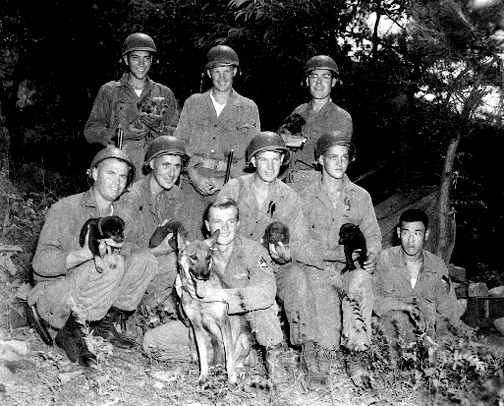
13.) Many war correspondents stopped by to get our story, but as I recall they never took any pictures of the platoon. We did get our pictures taken by the 13th Signal Company, 1st Cavalry Division in August, 1951, some good and some not so good. Don’t know if those pictures were ever seen by anyone other than myself. I wrote to the 1st Cavalry Division in 1952 requesting copies and was rewarded by 1st. Lt. Charles A. McAleer, Public Information Officer with the pictures and accompanying text. Some pictures were taken by members of the platoon, but I have been able to assemble only a very few. Two of them were taken when we got a visit from our friends in the Greek Battalion, the Regimental 4th Battalion supplied by the UN. Picture below shows me sitting with a Greek soldier friend, with three of the K-9’s in the background. The other picture shows me with my first dog ‘Red’.
14.) When I arrived in Korea I was carrying an M-1 rifle that I had zeroed in with a few rounds during a brief stop in Japan. I exchanged that for a BAR when I joined ‘Charlie’ Company, but when I transferred to the K-9 Platoon I took my good old M-1 with me. Handling a dog with an M-1 slung over the shoulder was far from ideal, and I soon traded that for an M-1 Carbine that one of our platoon members picked up when touring a recent battlefield. I was able to take it one step further and put the M-1 carbine aside for a 45 cal. automatic that I had traded a PX watch for with a Greek soldier. During the tour of the nearby battlefield where my M-1 carbine was found, Cpl. Don Smith found a Thompson sub-machine gun. While he was cleaning it of all the battlefield gore when the rest of us were at the noon meal, a shot was heard from the direction of our encampment. We knew immediately that Cpl. Smith was the culprit. Many accidental discharges of weapons behind the front lines had resulted in a fine of $100.00 being imposed for any such infraction. I’m not sure if anyone else was aware of Cpl. Smith’s indiscretion or not, but he never was called to anti up the $100. I never could understand Smith’s desire to carry that Thompson around because it and the equipment required to support it weighed a ton. My choice of a weapon was somewhat influenced by the premise that if I was involved in any action requiring shooting, it was my responsibility to get me and my valuable dog to a safe place and let the group I was with take care of the enemy, only joining in if things got out of hand.
15.) Some time after the platoon had gained it’s position as part of Regimental Hq. & Hq. Co., a young Korean student, maybe in his late teens or early twenties, attached himself to our unit. He was the son of a prominent medical doctor in Seoul, and spoke excellent english. If my memory serves me right, he had some university schooling. We secured him all the requirements of a full GI uniform and a carbine. One of the services he performed for the unit was to assist in the acquiring of additional dogs for training. Three of us, plus our young Korean assistant, drove into Seoul for a few days, where we saw his families upper-class home, and were introduced to the Chief of the Metropolitan Police Force. The chief was very supportive, and had his troops report the location in the city of all the dogs still living. With his intimate knowledge of the city, our young Korean friend took us to the addresses supplied, and we hit pay dirt with a mature female German Shepherd, that was a working dog of a Metropolitan Policeman. We convinced the owner, with the help of a $20.00 military script note, that it was his patriotic duty to turn over his dog to GARRY OWEN. Later our young Korean friend was drafted, and all of of efforts to persuade the Korean officals to have him remain with us failed.
16.) I took the leash and walked the dog around for about twenty minutes, talking to her all that time, and then when I thought it was safe, I picked her off the ground with one arm under her chest and the other arm under her rump, and we sat down in the rear seat of our Jeep. During the hour plus long ride back to our regimental camp site, Udi and I became fast friends. Since we were an American Army outfit, it seamed fitting that I convert her Korean name of Udi to Judy. Judy was trained in all disciplines, including attack dog.
16a.) The 7 th Cav. Regt. found itself over extended at one point and was directed to make a stratigic withdrawl. Our platoon was breaking camp, and I was loading the Jeep trailer with gear, with ‘Judy’ tied several feet away, when an airburst overhead, of a short 105 artillary round, resulted in a piece of steel, about he size of the end of your thumb, hitting the fender of the trailer. It hit the slope of the fender oppisit me and bounced away as I leaned over the side of the trailer. I found the steel fragment very hot when I picked it from the ground. ‘Judy’ was visiably shaken, and I inspected her for any damage, and found none. The next day was a different story. The shell fragment had struck ‘Judy’ on a rear hip, piercing the skin and bouncing off the bone. Overnight she had licked the wound, which enabled us to find it. We got her to the vet and she got treatment which allowed for complete recovery.
17.) The platoon was in the capitol city of Seoul for a brief time, bedding down inside a building that was part of the University complex. It just happened to coincide with the fact that ‘Judy’ was in heat, and the desire of the other platoon members to raise the morale of the K-9 complement. The mating of Judy took place at a time when I was absent from the unit. Judy’s work load remained normal during the pregnancy. It was at the time I was in Japan, enjoying R & R, that Judy gave birth to seven pups. The location of the birth was in my pup tent, and on my sleeping blankets. One pup was smothered during the process, but the remaining six were celebrated with a picture taken by Cpl. Paul J. Simons (BLQ)13 Sig Co (see above). The pick of the litter, and largest pup, was a male that probably had some of our beautiful Belgian Shepherd’s genes. Not long after the pups were born, I was able to rotate home. Would have taken the big pup home, but was convinced that doing so would delay my trip home. Was much dissapointed to find later that the Army allowed returning GI’s to take home all their pet dogs, all were far less special than the one I was interested in.
18.) Lt. Ted Cook took the pick of the litter for his own, and the others found a home. but subsequent letters from Korea indicated that all lived a very short life.
19.) The K-9 Platoon was never a formal part of the T O & E designed for Hq. & Hq. Company. As a result, when the company moved, the handlers and dogs rode on the top of the company supply truck. It was difficult to get the dogs up and down from the truck and more than not we would have to clean up a mess due to the dogs having suffered from motion sickness. Not very popular with the supply sergeant. Sgt. Sheldon’s answer was to steal some wheels. We wanted a 6X6 truck, but found them all chained and locked when unattended. Our first set of wheels was a Jeep from another division. Our next acquisition was a trailer for the Jeep. Our success with these procurments was due to the folowing arrangements.
20.) One of Sgt. Sheldon’s first volunteers from “Dog” Company was Cpl. Abrahamson from Texas. They became very close friends. Cpl. Abrahamson carried with him a 1st Lt’s silver bar of rank, given to him as a keepsake by his officer brother. They cooked up a scheme where Cpl. Abrahamson would pose as a First Lieutenant, wearing his brother’s badge of rank and the two of them, in a borrowed Jeep, would visit units behind the front line and scrounge needed items. Cpl. Abrahamson played his part to a tee, and made good friends of many of the young officers he asked help from. One of these friends was in a Combat Engineering Company, and we stopped in for many visits to socialize, eat a meal and secure fuel for our Jeep. This young Lt. was sympathetic to our supply problem, and when we stole our vehicles, we drove them to the Combat Engineeerig Co. area, and they painted them for us, adding the necessary bumper identification for our Hq. & Hq. Co.
21.) Nothing was said by anyone when we came home with this purloined equipment, until we tried for a second Jeep. For a while we were camped next to the Division Airfield “Saber’, and when we moved on we took with us a beat up Jeep that we figured no one would miss. The next morning we were all marched, under guard, to answer for our misdeed. It turned out the Jeep had belonged to the crew chief of the Division Commander’s airplane. Cpl. Joe Riley who had done the deed was charged with misappropriation of government material and was fined $50.00. We each chipped in $5.00 and Joe actually made money on the deal. Tents, new combat boots, and all manner of things that would make life easier were obtained in this fashion.
The following is Solon W. Duncan’s (year 2004) recollection of the events that preceded his capture by the Chinese Forces in Korea while serving as a member of the K-9 Detachment, Hq. & Hq. Co., 7th Cav. Regt.,1stCav Div
I believe it was in September 1951, I was in “L” Company, 7th Cavalry, on the front line when I noticed a G. I. with a German Shepherd dog. He came over to my fox hole; I ask him what he was doing on the front line with a dog. He said he was looking for volunteers for the K-9 Corp. Then he asked if I was interested. I said “yes”. He asked if I had any experience with dogs. I told him I hunted with bird dogs and deer hunted with hound dogs. He said I would qualify.
He talked to the Captain at the command post, then returned to my fox hole and told me I was now in the K-9 Corp. We left the front line and went to Hq. & Hq Co. where the K-9 unit was located. I trained with Judy and made friends with her for about two weeks. We worked on night patrols and out posts but never made contact with chinks, until November 4, 1951.
I was sent to an out post on Hill 200, I don’t know the exact location but I believe it was an out post 2000 yards in front of Bloody Baldy, could be wrong. At about 10 PM Judy let me know something was out there, I notified C. P. and told them my dog sensed something in front of us. I think the C. P. called in for artillery flares. They lit up the out post. We had double apron in front of our positions. You could see chinks everywhere. Then we had one hell of a fire fight that lasted about one hour.
I carried a M-2 Carbine and a 45 pistol. I ran out of ammo and started throwing hand grenades, had plenty of them. Judy was right under my feet. Then the fire fight stopped for about fifteen minutes. Then all of a sudden the Chinese started firing rockets at us. They threw about four barrages at us, there was nothing left on this hill. The only ones that got out alive were nine men and dog Judy: all taken prisoner.
Next morning November 5, 1951: I took Judy off the leash, hoping she would make it back to Hq. & Hq. Co., but she wouldn’t leave me, she stayed at my side. When we were marched off the hill we marched right by the rocket launchers that were on two Russian T-34 tanks. We marched two days behind Chinese lines. We held up at a Chinese camp in Korean huts the Chinese took over from civilians.
November 7, 1951: Chinese guards came and took me and Judy to a kitchen and made me tie Judy to a post with a grass rope. This was the last time I saw Judy. Then they marched me back to the shack where their Officers stayed. The interpreter wanted to know who Judy was. I told them she was our Mascot. They took my dog tags, my cigarette lighter, and my wrist watch. Then they took me back to my compound where the others were. I heard a gunshot, I am sure it was Judy.
After this we were marched to POW Camp #5, Pyoktong (on the Yalu River), North Korea and arrived December 10, 1951. Freed August 11, 1953.
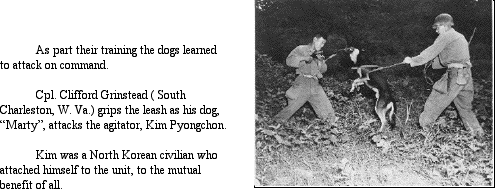
Recollections of Service with The War Dog Unit of the 7th Reg.1st Cavalry Div.
by George P. Mooren
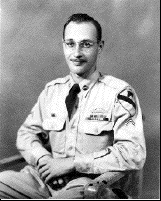 After serving in the Army in South Korea during the years 1946-1948 with the occupation forces, I joined the Inactive Army Reserves. In the Fall of 1950 I received a call to report for physical and was reactivated. We were given a 7 day refresher course, then flown to Korea as replacement troops.
After serving in the Army in South Korea during the years 1946-1948 with the occupation forces, I joined the Inactive Army Reserves. In the Fall of 1950 I received a call to report for physical and was reactivated. We were given a 7 day refresher course, then flown to Korea as replacement troops.
On my way from Pusan to the front lines I noticed a small group of GI’s in a field around a camp fire and asked what they were doing. The Captain said they were starting a K-9 Unit, so I asked if they needed a Vet. He told me to fall out and report to Sgt. Guy Sheldon. This was where I met Ted McKelvey, with whom I shared many foxholes. Our platoon was eventually built up to 9 or 10 dogs, each with their own handler. Sgt. Sheldon obtained Rabies vaccines, so he and I vaccinated all the dogs, including a female hound dog that could not be trained – would not keep quiet – but was kept around for the “male” companions. After six weeks’ training a K-9 and handler was sent out on patrols that were either foward or to the rear of our front lines.
Ted’s dog Judy was wounded by shrapnel to her left flank, but at that time we were on the move constantly so I couldn’t treat her properly. It was decided that I take her to the rear for convalescing. All went well, so I returned Judy to the front about one week later.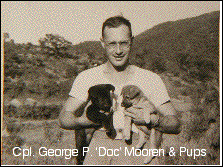
At another time, Mack Hatfield and his K-9 ‘Rebel’ returned from an all night patrol and Mack asked me to check Rebel. After taking his temperature I determined that he had Pneumonia, so I took him to the medical aid station and told the medic I needed a shot of 600 units of penicillin for Rebel. After receiving approval from the doctor, who confirmed that he had Pneumonia, he told the medic to give the dog the shot. The medic looked at the 120 lb. dog and said, “No Way!!” I took the needle from the medic, ordered Rebel to “lay down, Stay”, gave him the shot in his flank, and he never moved. I then took the leash and said, “Rebel – heel”. As I left to go back to our camp I heard the medic say, “I wouldn’t do that for $10,000 dollars!!” Rebel was back on duty in two days.
When Sgt. McKelvey was rotated home, I took control of the unit till the time I rotated home in December, 1951.
George Mooren appears on the left in his 1951 finery, and on the right with the proper 1999 Attire for a much delayed reunion with his former Garry Owens K-9 unit buddy. When it came to tenting they each supplied their half of equipment needed.
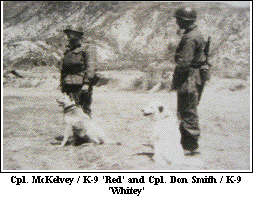
The following describes the relationship between Dog Handler and his Dog.
He is your friend, your defender, your dog.
You are his life, his love, his leader.
He will be yours, faithful and true,
To the last beat of his heart.
You owe it to him To be worthy of such devotion.
Anonymous
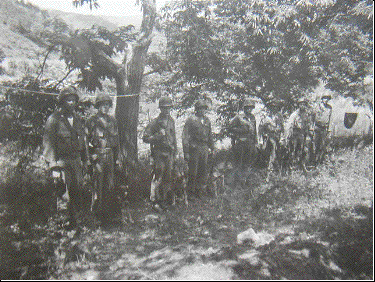
13th Signal Company photo: The Tactical War Dog Platoon, 7th Cav Regt, U S 1st Cav Div.
(L to R) 1st Lt Ted W Cook (Beckley, W. Va), Platoon Leader; Pfc Carl Brock (Bremen, Ind) and “Rex”; Sgt Theodore McKelvey (Crestwood, N.Y.) and “Judy”; Pfc Verle Steyer (Pioneer, Ohio) and “Joy”; Cpl Mack Hatfield (Hanover, W. Va) and “Rebel”; Cpl Clifford Grinstead (South Charlston, W. Va) and “Marty”; Pfc Edward Luksan (New Smyrna Beach, Fla) and “Red”; Pfc Edward Emmons (Granite City, Ill) and “Tippy”
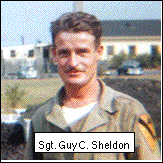 Sgt. Sheldon managed to have K-9 Teams from our unit join in on patrols conducted by Garry Owen’s Greek Battalion. These patrols produced the same positive results that the unit continued to experience. Those events started an effort by the Greeks to form a similar unit of their own. Sgt. Sheldon gave them two of our trained dogs to get started with and a program for them to use to train K-9 Teams. I remember that our meetings with the Greek unit had several enjoyable side benifits. We would take them chocolate and Coca-Cola and return with a case of figs and our canteens filled with Uzo.
Sgt. Sheldon managed to have K-9 Teams from our unit join in on patrols conducted by Garry Owen’s Greek Battalion. These patrols produced the same positive results that the unit continued to experience. Those events started an effort by the Greeks to form a similar unit of their own. Sgt. Sheldon gave them two of our trained dogs to get started with and a program for them to use to train K-9 Teams. I remember that our meetings with the Greek unit had several enjoyable side benifits. We would take them chocolate and Coca-Cola and return with a case of figs and our canteens filled with Uzo.
I have no idea if the Greek Military still maintains a K-9 Corp. If anyone reading this has any knowlege on that subject, please contact me.
Sgt. Sheldon started his efforts to form this K-9 Unit sometime in January, 1951. It operated with great success until the 7th Cav. Regiment redeployed to Camp Crawford, outside of Sapporo on Japan’s northern island of Hokkaido. All of the Dog Handlers were posted to other units. I have no knowledge of what fate the dogs, that had served their country so well, met with. Hopefully they returned to civilian status and lived their final years with kind friends.
Theodore D. McKelvey
